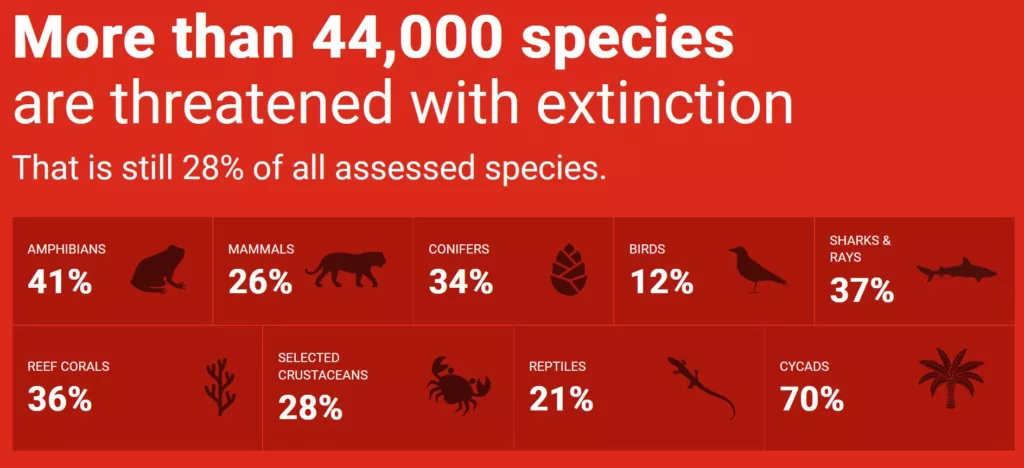Something often not focused on when addressing the impact of natural hazards are the difficulties experienced by all the different species in the area. Natural hazards like earthquakes, hurricanes, volcanoes, and tsunamis can leave many species in the area in unprecedented and starkly different conditions than they are used to in an extremely short amount of time. A new study looks at the four previously stated natural hazards and the frequency and magnitude at which they are occuring where at-risk species live in order to help guide efforts for ensuring their survival.
The International Union for Conservation of Nature (IUNC) keeps a Red List of the globe’s threatened species, constantly assessing new species and reassessing existing ones for their threat levels. These species are already at risk of extinction, so a natural hazard risks reducing their population numbers even more. Habitat loss and rapid local climate change can make them even more vulnerable. Identifying the species most at risk, the areas they reside in, and the natural hazards they are most susceptible to can inform conservation programs to ensure their survival.

In order to be able to make things easier, they grouped all species into amphibians, birds, mammals, and reptiles. They also picked the four most prevalent natural hazards: earthquakes, hurricanes, tsunamis, and volcanoes. They then had four species groups and four hazards, making 16 cross correlations to analyze, looking at the last 50 years of data about the location, magnitude, and frequency of the events. From this information, they were able to look at where certain species and hazards overlapped.
If less than 25% of the area where a species lived overlapped with areas of high impact from at least one of the natural hazards, they classified the species as at “risk.” If 25% or more overlapped with high relative impact from hazards, they were classified as “high risk.”
There were 8,813 total species considered to have a limited population size for the study. Of those, about 40% overlapped with regions that had one or more major natural hazards in the last 50 years—16% overlapped with two or more. About 23% were classified as high risk due to the four considered natural hazards. These high risk species were mainly found in the Neotropics and Indomalaysian biogeographic regions. Additionally, almost 70% of all the species considered were only found on islands, and the highest quantity of species at high risk from hazard activity was in the Ring of Fire.
In the species-specific breakdown, the highest risks were found in reptiles, followed by amphibians, birds, and then mammals. When looking at natural hazards posing risks, the most prominent were hurricanes (overlapping with 49% of species), followed by earthquakes (43%), tsunamis (13%), and then volcanoes (8%).
When looking at all 34,035 species of assessed terrestrial vertebrates (at risk or not), we see that 10% of all the four categories of species are at risk due to at least one natural hazard, while 5.4% are at high risk, with an overwhelming amount being island-dwelling species.

When compounded with human colonization of areas, the species have multiple pressures making their survival difficult. Many species have been able to evolve and respond to these in the past, but as climate-driven hazard frequency and magnitude is predicted to increase in the near future, they may be unable to adapt rapidly enough. Many species have already been displaced to new areas due to hazards, but also from the direct impact of human infrastructure, confining many species to even smaller areas and making them more susceptible to being wiped out by a single event.
Now more than ever, conservation efforts are needed for species at risk, and this study highlights that. According to an IUCN assessment of the species that the researchers looked at, only 15% had a specific conservation plan identified for them. The two types of conservation efforts are in situ (aiding species in their natural habitat) and ex situ (protection outside of their natural habitat). Areas where in situ preservation is possible would depend on the frequency and magnitude of the natural hazards that impact them. If possible, establishing protected areas for conservation and restoration could effectively lessen the impact of these events in a long-term timeline, increasing the extent of their habitat and creating a greater chance of survival. In many cases, however, the event is so severe that ex situ is the only viable option for conservation to avoid an entire population from being wiped out.
As we continue to intervene with conservation and restoration in mind, we can be effective in preventing extinction due to natural hazards. Many previous conservation efforts have been successful, and studies like this one help identify the areas and species that are most at risk. Continued research allows us to understand our own human impact on species survival and take action.

